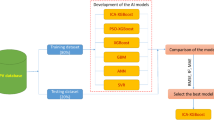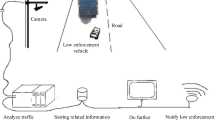Abstract
Automatic identification of the brand of the car is difficult to accomplish because the different brands have a lot of similarities. In this work, we developed a new system of Volkswagen vehicle identification. Firstly, the original car images were preprocessed by the watershed algorithm and manual revision. Secondly, we employed the wavelet entropy (WE) to extract efficient features from the car images. Thirdly, we used multilayer perceptron (MLP) as a classifier. At last, we chose the artificial bee colony (ABC) algorithm to train the MLP. The original ABC is good at exploration but poor at exploitation because of its equation system. So, we proposed a new model of the ABC called improved artificial bee colony (IABC) to balance exploration and exploitation. We used the 5 × 5-fold cross-validation for fair comparison. The experiment result showed that the overall specificity is 88.62%, the overall sensitivity is 89.16%, and the overall accuracy is 89.17%. Therefore, the proposed method is effective for Volkswagen vehicle identification. The result of the IABC provides better performance than ordinary ABC.
Access this chapter
Tax calculation will be finalised at checkout
Purchases are for personal use only
Similar content being viewed by others
References
Jang, D.M., Turk, M.: Car-Rec: a real time car recognition system. In: IEEE Workshop on Applications of Computer Vision (WACV). IEEE, pp. 599–605 (2011)
Huzaifa, M., Suwardi, I.S.: Car model recognition from frontal image using BRISK. In: International Conference on Electrical Engineering and Computer Science (ICECOS). IEEE, pp. 104–108 (2017)
Yang, L., Luo, P., Change Loy, C., Tang, X.: A large-scale car dataset for fine-grained categorization and verification. In: Proceedings of the IEEE Conference on Computer Vision and Pattern Recognition, pp. 3973–3981 (2015)
Jia, W.-J.: Ford motorcar identification from single-camera side-view image based on convolutional neural network. In: 18th International Conference on Intelligent Data Engineering and Automated Learning (IDEAL), Guilin, China, pp. 173–180. Springer (2017)
Deeb, R., Muselet, D., Hebert, M., Tremeau, A.: Interreflections in computer vision: a survey and an introduction to spectral infinite-bounce model. J. Math. Imaging Vis. 60(5), 661–680 (2018)
Wu, L.N.: Improved image filter based on SPCNN. Sci. China Ser. F-Inf. Sci. 51(12), 2115–2125 (2008). https://doi.org/10.1007/s11432-008-0124-z
Wu, L.N.: Segment-based coding of color images. Sci. China Ser. F-Inf. Sci. 52(6), 914–925 (2009). https://doi.org/10.1007/s11432-009-0019-7
Wei, G.: Color image enhancement based on HVS and PCNN. Sci. China Inf. Sci. 53(10), 1963–1976 (2010). https://doi.org/10.1007/s11432-010-4075-9
Zhang, Y.: Stock market prediction of S&P 500 via combination of improved BCO approach and BP neural network. Expert Syst. Appl. 36(5), 8849–8854 (2009)
Gorriz, J.M., Ramírez, J.: Wavelet entropy and directed acyclic graph support vector machine for detection of patients with unilateral hearing loss in MRI scanning. Front. Comput. Neurosci. 10, Article ID: 160 (2016). https://doi.org/10.3389/fncom.2016.00106
Mirjalili, S., Mirjalili, S.M., Lewis, A.: Let a biogeography-based optimizer train your multi-layer perceptron. Inf. Sci. 269, 188–209 (2014). https://doi.org/10.1016/j.ins.2014.01.038
Hou, X.-X.: Alcoholism detection by medical robots based on Hu moment invariants and predator-prey adaptive-inertia chaotic particle swarm optimization. Comput. Electr. Eng. 63, 126–138 (2017)
Yang, J.F., Sun, P.: Magnetic resonance brain classification by a novel binary particle swarm optimization with mutation and time-varying acceleration coefficients. Biomed. Eng.-Biomed. Tech. 61(4), 431–441 (2016). https://doi.org/10.1515/bmt-2015-0152
Ji, G.: A comprehensive survey on particle swarm optimization algorithm and its applications. Math. Probl. Eng. Article ID: 931256 (2015)
Phillips, P.: Pathological brain detection in magnetic resonance imaging scanning by wavelet entropy and hybridization of biogeography-based optimization and particle swarm optimization. Progr. Electromagnet. Res. 152, 41–58 (2015). https://doi.org/10.2528/PIER15040602
Ji, G.: An MR brain images classifier system via particle swarm optimization and kernel support vector machine. Sci. World J. Article ID: 130134 (2013). https://doi.org/10.1155/2013/130134
Ray, P.K., Mohanty, A., Panigrahi, B.K., Rout, P.K.: Modified wavelet transform based fault analysis in a solar photovoltaic system. Optik 168, 754–763 (2018)
Yang, M.: Dual-tree complex wavelet transform and twin support vector machine for pathological brain detection. Appl. Sci. 6(6), 169 (2016)
Liu, A.: Magnetic resonance brain image classification via stationary wavelet transform and generalized eigenvalue proximal support vector machine. J. Med. Imaging Health Inf. 5(7), 1395–1403 (2015). https://doi.org/10.1166/jmihi.2015.1542
Zhang, Y.D., Dong, Z.C., Ji, G.L., Wang, S.H.: An improved reconstruction method for CS-MRI based on exponential wavelet transform and iterative shrinkage/thresholding algorithm. J. Electromagn. Waves Appl. 28(18), 2327–2338 (2014). https://doi.org/10.1080/09205071.2014.967365
Huo, Y.: Feature extraction of brain MRI by stationary wavelet transform and its applications. J. Biol. Syst. 18(S), 115–132 (2010)
Zhan, T.M., Chen, Y.: Multiple sclerosis detection based on biorthogonal wavelet transform, RBF kernel principal component analysis, and logistic regression. IEEE Access 4, 7567–7576 (2016). https://doi.org/10.1109/ACCESS.2016.2620996
Hess, A.S., Hess, J.R.: Principal component analysis. Transfusion 58(7), 1580–1582 (2018)
Polutchko, S.K., Stewart, J., Demmig-Adams, B., Adams, W.: Evaluating the link between photosynthetic capacity and leaf vascular organization with principal component analysis. Photosynthetica 56(1), 392–403 (2018)
Kumar, A., Jain, V.: Feed forward neural network-based sensor node localization in internet of things. In: Progress in Computing, Analytics and Networking. Springer, pp. 795–804 (2018)
Li, Y.-J.: Single slice based detection for Alzheimer’s disease via wavelet entropy and multilayer perceptron trained by biogeography-based optimization. Multimedia Tools Appl. 77(9), 10393–10417 (2018). https://doi.org/10.1007/s11042-016-4222-4
Sun, Y.: A multilayer perceptron based smart pathological brain detection system by fractional fourier entropy. J. Med. Syst. 40(7), Article ID: 173 (2016). https://doi.org/10.1007/s10916-016-0525-2
Ji, G.: Fruit classification using computer vision and feedforward neural network. J. Food Eng. 143, 167–177 (2014). https://doi.org/10.1016/j.jfoodeng.2014.07.001
Li, P., Liu, G.: Pathological brain detection via wavelet packet tsallis entropy and real-coded biogeography-based optimization. Fundamenta Informaticae 151(1–4), 275–291 (2017)
Wu, X.: Smart detection on abnormal breasts in digital mammography based on contrast-limited adaptive histogram equalization and chaotic adaptive real-coded biogeography-based optimization. Simulation 92(9), 873–885 (2016). https://doi.org/10.1177/0037549716667834
Wei, L.: Fruit classification by wavelet-entropy and feedforward neural network trained by fitness-scaled chaotic ABC and biogeography-based optimization. Entropy 17(8), 5711–5728 (2015). https://doi.org/10.3390/e17085711
Hancer, E., Xue, B., Zhang, M., Karaboga, D., Akay, B.: Pareto front feature selection based on artificial bee colony optimization. Inf. Sci. 422, 462–479 (2018)
Badem, H., Basturk, A., Caliskan, A., Yuksel, M.E.: A new hybrid optimization method combining artificial bee colony and limited-memory BFGS algorithms for efficient numerical optimization. Appl. Soft Comput. 70, 826–844 (2018)
Hon, M.K., Mohamad, M.S., Salleh, A.H.M., Choon, Y.W., Remli, M.A., Ismail, M.A., Omatu, S., Corchado, J.M.: A hybrid of simple constrained artificial bee colony algorithm and flux balance analysis for enhancing lactate and succinate in Escherichia Coli. In: International Conference on Practical Applications of Computational Biology and Bioinformatics. Springer, pp. 1–8 (2018)
Akay, B., Demir, K.: Artificial bee colony algorithm variants and its application to colormap quantization. In: Evolutionary and Swarm Intelligence Algorithms. Springer, pp. 25–41 (2019)
Weiner, K.S., Barnett, M.A., Witthoft, N., Golarai, G., Stigliani, A., Kay, K.N., Gomez, J., Natu, V.S., Amunts, K., Zilles, K.: Defining the most probable location of the parahippocampal place area using cortex-based alignment and cross-validation. Neuroimage 170, 373–384 (2018)
Acknowledgements
This work is partly supported by the National Natural Science Foundation of China under Project Code (61803301, 61272283, 11361001, 61573281, U1334211), the China Postdoctoral Science Foundation (2014M562435) and the Natural Science Research Program of the Educational Office of Shaanxi Province (15JK1518).
Author information
Authors and Affiliations
Corresponding author
Editor information
Editors and Affiliations
Rights and permissions
Copyright information
© 2020 Springer Nature Singapore Pte Ltd.
About this paper
Cite this paper
Yang, J., Wang, L., Jiang, Q. (2020). Volkswagen Vehicle Identification via Multilayer Perceptron Trained by Improved Artificial Bee Colony Algorithm. In: Satapathy, S., Bhateja, V., Nguyen, B., Nguyen, N., Le, DN. (eds) Frontiers in Intelligent Computing: Theory and Applications. Advances in Intelligent Systems and Computing, vol 1014. Springer, Singapore. https://doi.org/10.1007/978-981-13-9920-6_15
Download citation
DOI: https://doi.org/10.1007/978-981-13-9920-6_15
Published:
Publisher Name: Springer, Singapore
Print ISBN: 978-981-13-9919-0
Online ISBN: 978-981-13-9920-6
eBook Packages: Intelligent Technologies and RoboticsIntelligent Technologies and Robotics (R0)




